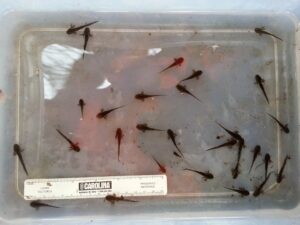Ecological restoration is a slow process. Often, we must wait several years to see if our work is paying off. Plants must mature, flower, and spread seeds. Turtles often don’t reach reproductive maturity until 16 years of age or even later. Restoration of entire habitats can take literal decades before the environment becomes functional for all the wildlife who depend on it (especially if you’re growing trees!)
This long wait time makes the actual payoff even more exciting, and this week, we’re really excited to share such a payoff with you! After six years of captive rearing and translocation efforts, we’ve gotten confirmation that a wild marbled salamander larva has been found at the Middlesex Fells. This is one of the first wild individuals hatched at the Middlesex Fells in 90 years – a landmark win for conservation.

Marbled salamanders (Ambystoma opacum) used to breed freely at the Middlesex Fells, the large urban preserve that spreads across several town and abuts the Stone Zoo. Some time in the 1930s, the salamanders became locally extinct when increasing urbanization made the habitat unsuitable for them. Now a Threatened species in the state of Massachusetts, marbled salamanders mostly occur in isolated, rocky areas with the right hydrology to host the temporary fall and winter pools they rely on for breeding. That’s right: unlike the rest of our salamanders, which breed in the spring, marbled salamanders breed and lay eggs in the fall. Their tough larvae hatch and grow in icy pools during the winter, giving them an advantage over other salamanders that are still eggs or babies when the marbled crew are metamorphosing into land-dwelling juveniles.
Ever since 2016, Zoo New England staff have been carefully collecting larval salamanders from a robust population in western Massachusetts and rearing them to their juvenile stage in human care, both at Stone Zoo and at local schools as a classroom program. We have released more than 300 salamanders at the Middlesex Fells with the goal of re-establishing the vanished population. Marbled salamanders are nearly impossible to track after release; they are too small to carry a radio tracker and spend most of their lives hunting invertebrate prey underground (this is why their genus is called “mole salamanders”). All we could do after releasing the young was cross our fingers and hope…but that hope was rewarded. Check out the video below:
This year, a volunteer biodiversity survey by Zoo New England’s partner organization Earthwise Aware found a larval salamander at one of the Fells’ temporary pools in late February. Biologists knew that marbled salamanders are the only species that could have larvae at this time of year, and closer examination proved the identification correct. The presence of this larva means that some of Zoo New England’s released juveniles have successfully matured, found one another, and laid eggs. While the marbled salamander population at the Fells is still a small one, this success story six years in the making proves that dedicated effort can reverse some of the changes humans have caused in our environment.
